There are two aspects of a good suit pant fit that I’ve learned to embrace since becoming enamored of tailored clothing about a decade ago.
[Read part 1 of this article, Adjusting Your Perceptions of What Fits here]
First, is rise. When I was younger, I felt that the correct height to wear all pants, including suit pants, was right about my hips, where jeans usually sit. That’s where pants sort of naturally fall, and any higher than that felt weird to me. But guess what—that’s vastly less flattering, particularly on a suit. I explain why in my eBook here, but suffice it to say, I learned the benefits of a higher rise early on once I started dressing better as an adult.
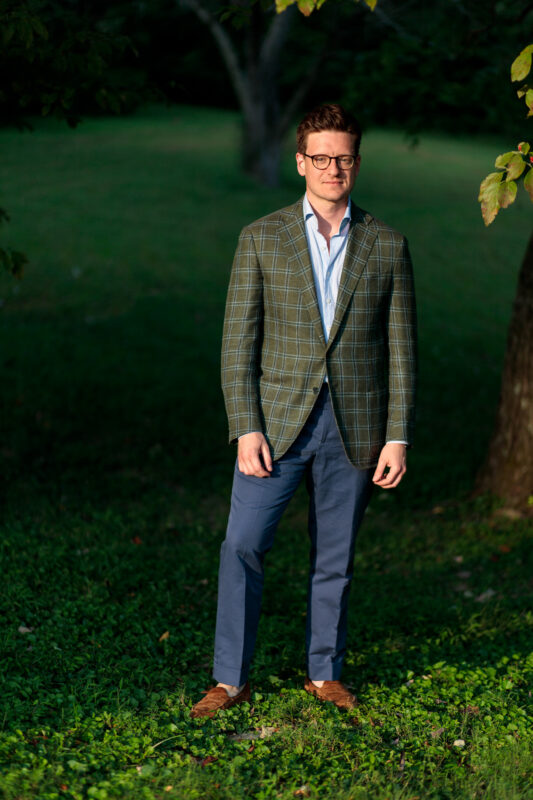
With regard to rise, less discussed is the importance of the back rise, which is the distance from the crotch seam to the top of the waistband in the back. Simply put, this is the measurement that takes into account your seat. One time I got a pair of slim dress pants in Europe and the back rise was so incredibly low, even just standing still they would’ve showed my underwear, or worse (I bought them without trying them on).
A higher rise in general means that the back rise will be higher, too, and that’s important because you don’t want them to ride low when you sit down. But if the rise is too high for your physiology in relation to the front rise, it causes ripples in the pant legs as the seat of the pants hangs loose in the back. A tailor will usually see that and can adjust it.
But the primary takeaway I want to give you is: Look for a higher rise in the front. It lengthens your legs visually to make you look taller and complements a tailored blazer or suit jacket better.
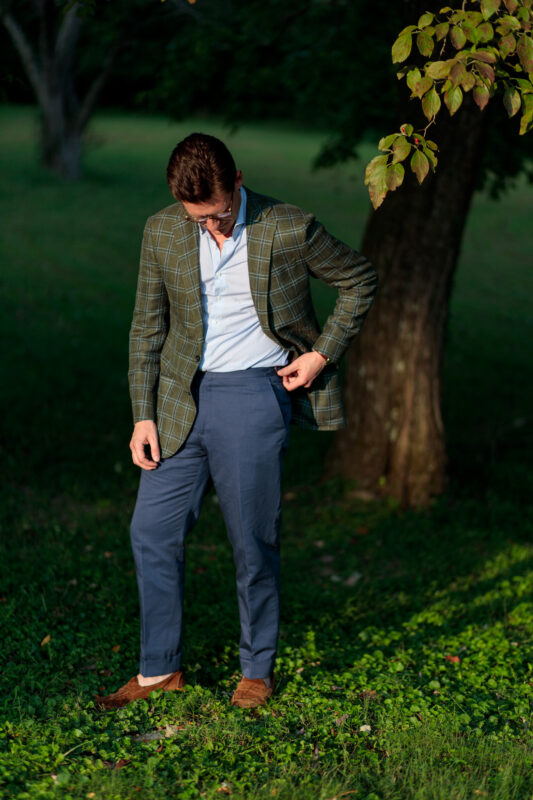
Second is a completely under-represented measurement in the leg: the knee. You see, there seem to be two opposite ditches people fall into: the skinny suit pant leg that is fully form-fitting, or the triple-pleated balloon pants that pool around the ankle. I think that happens because doing something in the middle—a moderate, slim straight fit as I prefer—is very difficult to actually pull off without going full custom. I tended toward slimmer trouser silhouettes for years because I didn’t like how most suit trousers would sort of billow out near the lower thigh and knee. But the problem is if you go too slim, the thighs themselves get tight and the pants stick on your calves. That both ruins any clean line you might have in the front, as well as makes you look goofy when you stand up—you have to pull the hem down off your leg.

The key is finding a straight-fitting leg that has enough room in the thigh to comfortably sit down. To estimate that, measure your thigh while standing and add 3-4 inches to get how wide the thigh of a pair of pants should be. But from there, it should have a subtle little taper in the knee. With a correct back rise for your body, which stops excess fabric from rippling downward from your seat, it will make trousers drape cleanly without looking chunky at the knee. It’s tough to nail it down, but once you realize those are the two measurements that often make the difference between a “blah” pair of pants and a “oh these are flattering” pair of pants, it’s freeing. You can have those adjusted through a cheap alteration if necessary.
It will take some trial and error. If you go too slim in the knee, it makes the thighs tight when you sit down as the pant rides up, shoving your leg further down into that taper. After erring on the slightly too slim side of the divide, I’ve loosened back up a little to give myself some extra room, but not so full that they sag weirdly like on other pants of the past.

So there are my two important trouser fit tips for what to look for. I hope this is helpful when trying to determine why some pants look more flattering than others on you.
My personal favorite-fitting pants are from Spier & Mackay. They’re just about perfect for what I describe above in their contemporary fit. I take my normal dress trouser size—not my vanity size for jeans or shorts or whatever, but the actual measurement of my actual waist at its narrowest part—and subtract 1. So my actual size is 36, and I take a 35. The brown and light navy cotton-linen trousers throughout this post are how that looks on me.
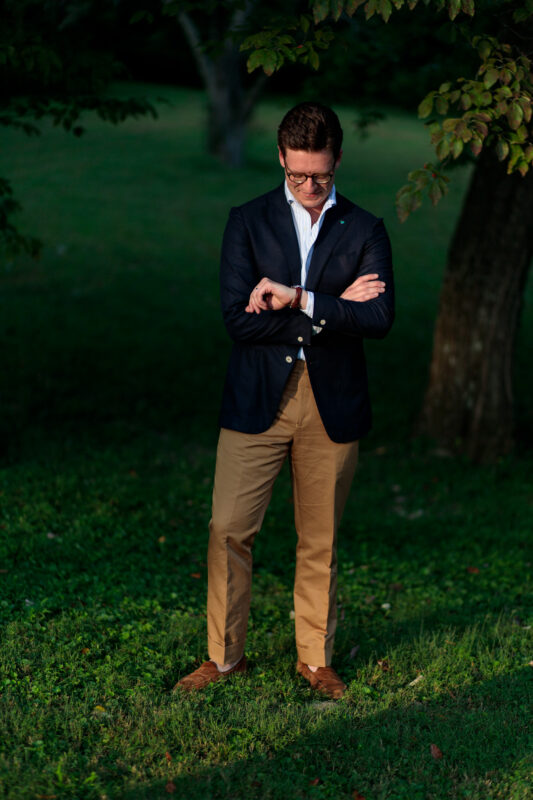
If you have a slimmer build, their slim fit works well, too. The rise is lower, which I don’t like, but whether it works well on you just depends on your build.
Let me know in the comments below what aspects of trouser fit you find most important in getting right.
(Help support this site! If you buy stuff through my links, your clicks and purchases earn me a commission from many of the retailers I feature, and it helps me sustain this site—as well as my menswear habit ;-) Thanks!)
If you’re just getting into tailored menswear and want to level up your style faster, buy my eBook. It covers wardrobe essentials for any guy who wants to look cool, feel cool and make a good impression. Formatted for your phone or computer/iPad so it’s not annoying to read, and it’s full of pretty pictures, not just boring prose. Buy it here.





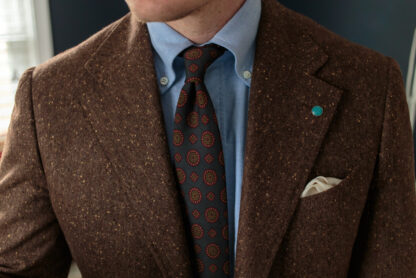
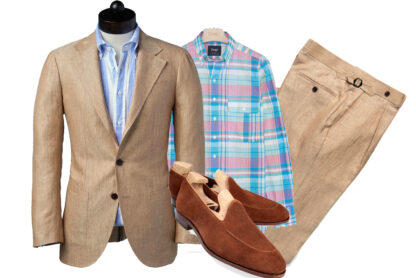



Thank you for the tips! I’m new to menswear and this is a good read as I’m waiting for Spier and Mackay’s to release their flannel high rise trousers (I’m in the pre-order for their cream cords). Also, had a light bulb moment on why my chinos pull up when I sit down and am constantly pulling the ankle of my pants down. Outside of Spier and Mackay, do you have recommendations for flannel trousers? Looking for light and mid-greys for this season.
No problem, glad it’s helpful.
I’d check out the Regent fit from Brooks Brothers. They’re about 2x the price but also go on sale fairly regularly. They did add stretch these last few years, but I’m sort of over worrying about that. Linked here: https://www.brooksbrothers.com/Regent-Fit-Stretch-Flannel-Trousers/MJ00210,default,pd.html
Dapper Classics, Hertling, Sid Mashburn, Epaulet, are all good options too, though again in that higher price tier. I’m interested in Natalino—if you like pleats—though currently they only have covert twills up online right now.
The reason I love Spier so much is the outstanding value for VBC cloth in a fit that’s actually classic (i.e. mid-high rise). I’m sure they’ll have some flannels for you this season, and if not there’s always the MTO program.
Thanks for reading!
Thanks for the suggestions. I decided to try out the Natalino flannel trousers in light grey. Slightly out of my comfort zone with the double pleats. I hope this will work out while I wait for S&M’s 2020 flannel release.
I completely agree with this, but would have added one point related to rise that’s omitted here: it’s useful to have your waistband approach the top button of your jacket to avoid showing that messy patch of shirt through the quarters of the jacket, above the waistband. I can also vouch for the problem of slim trousers getting caught on the calves and looking rumpled below the knee. The absolute worst. Good tailoring is all about clean lines, and finding a good trouser fit that’s high-waisted and moderately slim while retaining those clean lines is key.